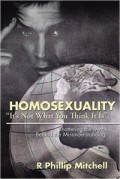Title: Homosexuality: “It’s Not What You Think It is”
Author: R. Phillip Mitchell
Publisher: AuthorHouse
ISBN: 978-1-5049-5368-9
Pages: 99
Genre: Non-Fiction
Reviewed by: Gary Sorkin
Pacific Book Review
My first thought when seeing the cover of Dr. R. Phillip Mitchell’s book titled Homosexuality: “It’s Not What You Think It is”: Shattering the Myths Behind the Misunderstanding – was how can he say it’s not what I think it is? After all, how can he possibly know what I, an unbeknownst to him reader, think homosexuality is in the first place? Well, I must admit, he was correct.
Mitchell has comprised this book, now in its 2nd revised edition, by his over 20 years of research and information gathered in clinical experience dealing with issues of human sexuality. Included and separated into terse chapters within this book, he begins with a reveal of his intensive research on the subject; from the philosophical opinions of the Greeks such as Socrates and Plato; to the origin of the word “homosexual” itself; encompassing the legal and social aspects of the culture and progressing all the way to the interpersonal though patterns of those whose lives are touched by this. With his non-judgmental posture of a doctor and scholar, he embellishes quite articulately the challenges and courses of development of this widening aspect of the homosexual culture in modern times. What is a rather quick read, becomes an indelible impact in the reader’s mind, having the complex subject matter resonating long after the book is completed. In dealing with the points of Mitchell’s presentations, homosexuality, in all of what that encompasses, is in fact proven to be not what you thought it was in the first place.
Certainly the reader will be moved by the stories of children growing up with both the internal pressures of personal sexuality being torn against the rules of society, as well as others as the external pressures of adults acting upon the youngster’s personal innocence being violated. Many of these types of stories have been brought to the public’s awareness through countless news articles, the media of every sort, and social interactions and for some, personal experiences. But what caught me by surprise was the depth of the medical understanding of the root causes of homosexual behavior being manifested in so many, frankly unimaginable, ways.
For example, with the onset of AIDS and other STD’s, some early visible symptoms of these diseases deal with labored breathing, high fever, rashes and dermatological issues, even a skin tumor called Kaposi’s sarcoma and a virus called cytomegalovirus. Back in the 1970’s health officials thought the statically high number of cases of dysentery, in the Greenwich Village community, may have been due to bacteria in the water supply. When it was determined in fact these infections were traced to exposure to fecal material entering the anus or mouth through sexual acts as being the source, the view of homosexual activity became a blip on the radar of health officials and no longer could be kept in the closet. New medical methodology dealing with gay issues became prominent in the practice of disease control.
At the onset of the book, the reader is asked by the author to keep an open mind when reading this book. Mitchell’s case studies, philosophies and historical facts may shock some people of Christian faith, however all readers will be enlightened to the complexities of this integral part of human behavior. Skillfully executed in a polite and informative way, Mitchell will ultimately uphold the title of Homosexuality: “It’s Not What You Think It is.”


